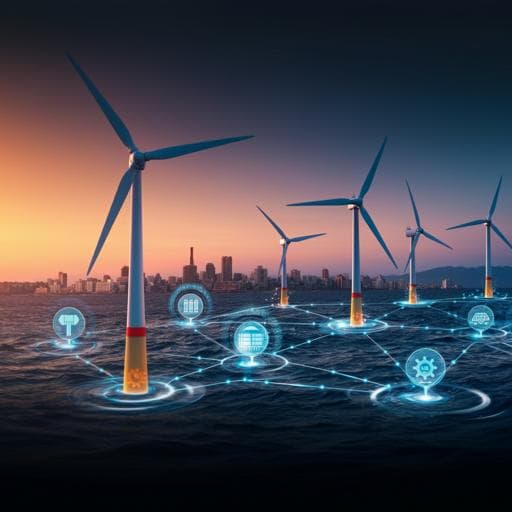
Engineering and Technology
Offshore wind and wave energy can reduce total installed capacity required in zero-emissions grids
N. Gonzalez, P. Serna-torre, et al.
This groundbreaking research by the team of experts explores how integrating offshore wind and wave energy can transform the Western Interconnection's electricity grid into a zero-emissions powerhouse by 2050. Discover the cost targets and the significant reductions in capacity that can be achieved through full deployment.
~3 min • Beginner • English
Introduction
Many states in the Western Interconnection have pledged clean energy targets by 2030–2050, creating an urgent need to identify least-cost, reliable pathways to zero-emissions electricity. Offshore wind and wave energy are abundant along the U.S. West Coast (offshore wind ~800 TWh/yr; wave ~240 TWh/yr, together ~1.2× 2021 WECC demand), yet have seen little or no commercial deployment in the region. Technical, environmental, permitting, and cost barriers have historically constrained both resources, and most decarbonization studies omit them or treat them simplistically. Wave energy offers predictability (up to 3 days ahead) and seasonal complementarity with solar and wind; offshore wind has higher capacity factors and public acceptance relative to land-based wind. The study’s research question is how including offshore wind (fixed-bottom and floating) and wave energy—independently and with potential collocation—affects the optimal technology mix, total capacity needs, curtailment, storage, and transmission in achieving a zero-emissions Western Interconnection by 2050. The purpose is to identify cost targets at which these technologies become cost-effective and quantify their system-wide impacts, thereby informing policymaking, technology development, and grid planning.
Literature Review
Prior U.S. decarbonization studies have analyzed least-cost portfolios and roles of specific technologies, such as BECCS enabling carbon-negative grids (ref. 1), firm low-carbon resources (nuclear, hydropower, geothermal, bioenergy, gas with CCS) reducing decarbonization costs (ref. 2), and CSP with thermal storage competing with short-duration storage (ref. 3). However, many omit offshore wind and wave energy. Studies on wave-wind integration have explored complementarity and power smoothing (e.g., southern Sweden using production cost modeling, ref. 23), spatiotemporal smoothing across UK wave sites (ref. 29), and localized grid impacts of an Oregon wave test site (ref. 30). Offshore wind integration studies have focused on stability and market impacts or stylized networks (refs. 31–34). A recent U.S.-wide capacity expansion analysis assessed offshore wind’s role under varying assumptions but did not include wave energy or collocation (ref. 35). This work fills gaps by modeling both fixed-bottom and floating offshore wind and wave energy within a capacity expansion framework for the WECC, explicitly evaluating relative cost targets, deployment, and collocation effects on the 2050 zero-emissions grid.
Methodology
The study evaluates offshore wind and wave energy in the Western Interconnection using the SWITCH WECC capacity expansion model to 2050 under zero emissions.
Site identification and candidate projects:
- Initial wave sites of industry interest were scored by CalWave using a weighted framework (wave resource, distance to shore, water depth, wind resource, bathymetry, local population density) aligned in part with NREL methodologies. Top ~100 sites were selected.
- Sites were filtered to exclude strictly protected MPAs (No Take, No Impact, No Access), military danger/restricted zones, and UNESCO WHMS overlap (none overlapped). Four sites overlapping restricted areas were removed.
- Candidate project polygons were created in QGIS, aligned parallel to shore, ensuring non-overlap and exclusive classification as shallow (≤60 m, fixed-bottom wind) or deep (>60 m, floating wind). Five BOEM offshore wind Call Areas (Coos Bay, Brookings, Humboldt, Morro Bay, Diablo Canyon) were added, yielding 101 candidate areas.
- No maximum water depth was enforced due to uncertain 2050 technology limits; <5% of areas extend beyond ~1300–1500 m depth.
Resource and performance data:
- Wave energy: Representative WEC is Sandia/NREL Reference Model 6 (RM6) oscillating WEC (rated 350.5 kW) with a power matrix from NREL’s Marine Energy Atlas. Hourly significant wave height and energy period time series (2006) were derived by linearly interpolating WPTO 3-hour data to 1-hour resolution for coordinates within each area and averaging per area. Capacity factor CF = Pa/Pr computed via power matrix. WEC array packing density assumed 1.0515 MW/km² (based on RM6 array layout). Wake effects for WECs were not modeled due to design dependence and limited data.
- Offshore wind: Representative turbine is NREL 2020 ATB Reference 15 MW (hub height ~150 m, rotor 240 m). Hourly wind data from NREL Offshore NW Pacific dataset (5-minute WRF-based, aggregated to hourly) for 9207 points within project areas were averaged per area to compute hourly capacity factors using the turbine power curve and operating limits. Turbine packing density assumed 4.3 MW/km² (based on Morro Bay Wind Energy Area theoretical density). Wind turbine wake effects were not modeled.
Scenario design and costs:
- 25 scenarios combine five wave energy cost targets and five offshore wind cost targets for 2050. Wave energy targets: (i) 50% cost reduction by 2050 (to ~$1732.5/kW overnight and $52.70/kW-yr O&M), (ii) parity with 2020 land-based wind, (iii) parity with 2050 land-based wind, (iv) parity with 2020 utility PV, (v) parity with 2050 utility PV (most optimistic, e.g., ~$618/kW overnight, $13.25/kW-yr O&M). Linear interpolation assumed from 2020 baseline costs ($3465/kW overnight; $105.4/kW-yr O&M).
- Offshore wind targets: NREL 2022 ATB conservative, moderate, advanced for fixed-bottom and floating, plus “very conservative” (ATB conservative + offsets) and “very advanced” (ATB advanced − offsets). Offsets: fixed-bottom ±$488.39/kW overnight and ±$15.90/kW-yr O&M; floating ±$720.55/kW overnight and ±$14.98/kW-yr O&M (2018$).
- All offshore projects include an interconnection cost of $487,000/MW (2018$).
SWITCH WECC model configuration:
- Linear programming least-cost capacity expansion and dispatch model covering WECC with 50 load zones connected by aggregated transmission (105 existing lines; model may expand existing or build new lines; derating and losses included).
- Investment periods: 2020, 2030, 2040, 2050, with a zero-emissions constraint WECC-wide by 2050. Operations represented by two representative days per month (peak and median) at 4-hour resolution (144 hours/year/period with weighting to represent full months).
- Technology portfolio: existing and potential new solar, land-based wind (3TIER/WWSIS-based), offshore wind, wave, hydro, geothermal, biomass, nuclear, gas, oil, coal, storage (battery and pumped hydro), with geolocated hourly CF series for >7000 potential new onshore renewables. Fuel price projections from EIA; costs primarily from NREL ATB (2018$ base year in SWITCH). Hydropower constrained by historical monthly availability. Policy and operational constraints include power balance by zone, generator and transmission capacity limits, maintenance, RPS/carbon caps, and resource potentials.
- The analysis focuses on 2050 results; transitional period results (2020–2040) are in Supplementary Information.
Key Findings
- Total installed capacity decreases as offshore wind and wave energy costs decline. Between the most expensive case and a low-cost case (scenario 1 vs. 24), total capacity falls by 133 GW (about 17%), largely driven by offshore wind deployment. Across wave energy cost reductions alone, total capacity decreases by up to ~3%.
- Solar capacity requirements drop substantially with greater offshore wind and wave deployment: a reduction of 132 GW (−39%) in solar capacity between scenarios 1 and 25, while solar remains the dominant generation source.
- Energy storage capacity declines with lower offshore wind and wave costs, especially as offshore wind becomes cheaper: up to 60 GW reduction (−37%), lowering storage’s share of total capacity from 44% to 32%.
- Operationally, offshore wind and wave provide relatively flat diurnal profiles, reducing midday solar and storage charging peaks and mitigating duck-curve effects. On a 2050 peak-demand day, the solar generation peak declines by up to 26% as offshore wind and wave penetration increases.
- Offshore wind capacity rises from ~2 GW to 59 GW across scenarios (from ~0.3% to ~9% of total capacity). Wave capacity rises from 3.7 GW to 40 GW (from ~0.6% to ~5.5%), the latter reaching ~93% of modeled wave potential (given 101 candidate sites) at PV-parity costs (~$618/kW overnight, $13.25/kW-yr O&M).
- Coastal system impacts: With higher offshore wind and wave deployment, coastal zones (about 42% of WECC load) see flatter generation profiles, less reliance on imports, and more exports. From scenario 1 to 25, coastal imports fall 31% annually and exports rise 58%. Generation-to-load ratios rise: CA 0.87→0.94, WA 0.78→0.84, OR 1.04→1.63.
- Curtailment increases with higher offshore wind and wave deployment: total renewable curtailment rises by up to 49 TWh (+48%), corresponding to a 3.4% increase in the share of total available renewable energy curtailed. Over half of the increase is due to added curtailment of land-based wind and solar.
- Transmission effects diverge by technology: cheaper wave energy leads to less new land-based transmission (−21.8 GW, −15%), while cheaper offshore wind leads to more transmission (+80 GW, +92%), reflecting coastal-to-inland power flows as coasts become generation centers.
- Collocation rises as costs fall: from zero collocated sites (scenario 1) to 28 of 101 sites (23% of installed offshore and/or wave projects) in low-cost scenarios.
- Total system cost (NPV over 2020–2050, 2018$) declines by up to 4% in scenarios with greater offshore wind and wave deployment. Components: 2050 fuel costs −0.9% (driven by −7.8% biomass generation), storage fixed costs −50%, generator O&M −1.4% and fixed −2.3%. Transmission fixed costs can increase up to +28% with more offshore wind (but decline with more wave energy).
Discussion
Even modest penetrations of offshore wind and wave energy materially reshape a zero-emissions 2050 WECC grid by reducing overbuild needs, shifting generation from highly diurnal resources (solar) toward more consistent marine generation, and thereby lowering storage requirements and mitigating duck-curve challenges. The modeled 17% reduction in total installed capacity (133 GW) when marine resources are inexpensive indicates that these technologies can provide substantial system value beyond pure energy contribution, by improving the alignment of supply with demand and reducing the need for peaking and storage capacity. The trade-offs include increased renewable curtailment and, for offshore wind in particular, higher needs for land-based transmission to move coastal generation inland. Wave energy, when cost-competitive, can help reduce transmission expansion compared to offshore wind alone, suggesting value in a balanced marine portfolio and collocation. To achieve >10% reductions in total installed capacity relative to cases without marine resources, offshore wind costs would need to reach the NREL 2022 ATB advanced trajectory and wave energy costs decline by at least 50%. Policy initiatives like DOE’s Floating Offshore Wind Shot (targeting ~$45/MWh by 2035) underscore the plausibility of such cost declines. Collocation is favored by the optimization and likely even more attractive in practice if shared infrastructure costs (e.g., underwater transmission) are credited. Overall, marine technologies can enhance regional self-sufficiency in coastal states, support inland demand via expanded transmission, and reduce reliance on large swings in solar and storage, helping to meet zero-emissions targets at lower total system cost.
Conclusion
This study contributes: (1) a high-resolution capacity expansion assessment modeling offshore wind (fixed and floating) and wave energy as independent technologies with potential collocation for the WECC; (2) quantified cost targets at which these resources become cost-effective in a zero-emissions 2050 grid; (3) evidence that low-cost marine deployments can reduce total installed capacity by up to 17% and markedly reduce solar and storage requirements; and (4) quantified impacts on curtailment, coastal imports/exports, land-based transmission, and collocation prevalence. Policy and industry implications include prioritizing R&D, supply chain development, and incentives to accelerate cost declines for both offshore wind and wave energy, and actively planning for collocation and shared infrastructure to minimize integration costs. Future research should: incorporate explicit shared underwater transmission cost benefits and site-specific connection costs, refine spatial constraints (e.g., pipelines, shipping lanes), evaluate environmental siting trade-offs, run higher temporal-resolution scenarios including full-year hourly dispatch and interactions with long-duration storage, and expand analyses of co-designed wind–wave arrays and their grid services.
Limitations
Key limitations include: (1) the model does not capture cost savings from shared underwater transmission and other shared offshore infrastructure in collocated wind–wave projects; (2) site filtering did not incorporate all potential constraints (e.g., existing underwater pipelines/cables, shipping routes, additional archaeological or residential proximity constraints), which could alter site shapes/areas locally; (3) no maximum water depth was enforced, and a small subset of candidate areas extend beyond ~1500 m, potentially optimistic without added cost multipliers; (4) temporal resolution is reduced (two representative days per month at 4-hour intervals) which may under-represent short-term variability and marine resource complementarity, though trends are expected to hold; (5) wake effects for both WECs and offshore wind turbines were not modeled; (6) uniform interconnection cost assumptions were applied rather than site-specific bathymetry-dependent connection costs. These factors may shift some quantitative results but are unlikely to overturn the qualitative system-level insights.
Related Publications
Explore these studies to deepen your understanding of the subject.







